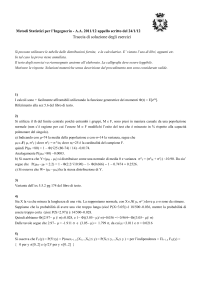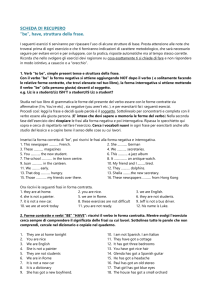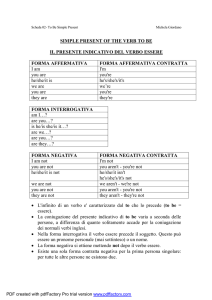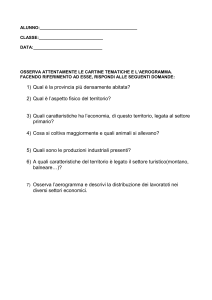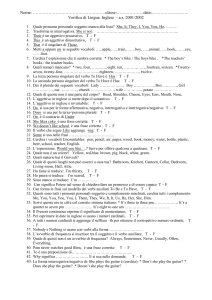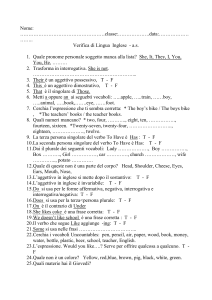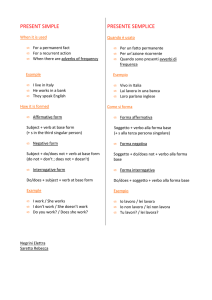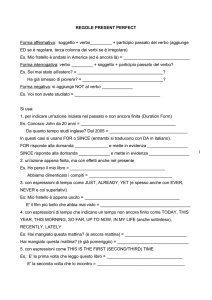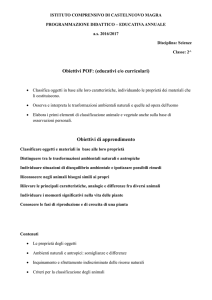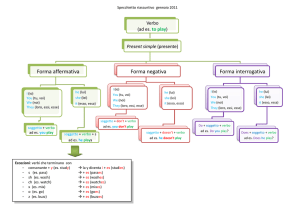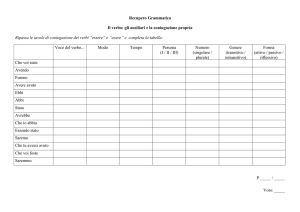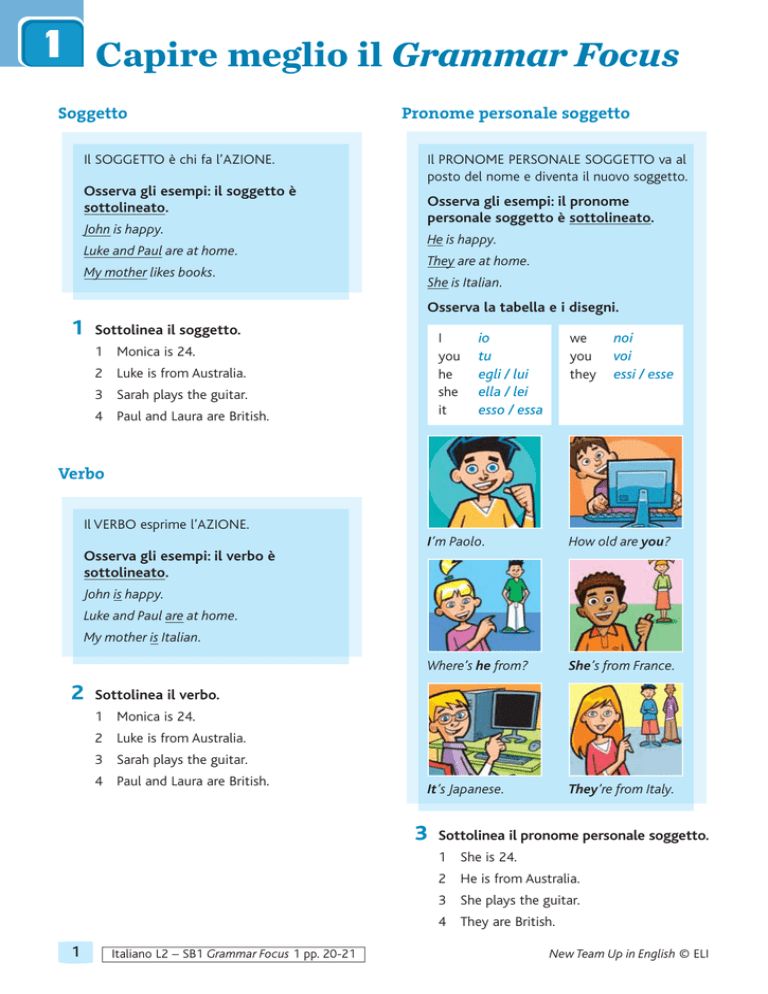
1 Capire meglio il Grammar Focus
Soggetto
Il SOGGETTO è chi fa l’AZIONE.
Osserva gli esempi: il soggetto è
sottolineato.
John is happy.
Luke and Paul are at home.
My mother likes books.
Pronome personale soggetto
Il PRONOME PERSONALE SOGGETTO va al
posto del nome e diventa il nuovo soggetto.
Osserva gli esempi: il pronome
personale soggetto è sottolineato.
He is happy.
They are at home.
She is Italian.
Osserva la tabella e i disegni.
1
Sottolinea il soggetto.
I
you
he
she
it
1 Monica is 24.
2 Luke is from Australia.
3 Sarah plays the guitar.
4 Paul and Laura are British.
io
tu
egli / lui
ella / lei
esso / essa
we
you
they
noi
voi
essi / esse
Verbo
Il VERBO esprime l’AZIONE.
I’m Paolo.
How old are you?
Where’s he from?
She’s from France.
It’s Japanese.
They’re from Italy.
Osserva gli esempi: il verbo è
sottolineato.
John is happy.
Luke and Paul are at home.
My mother is Italian.
2
Sottolinea il verbo.
1 Monica is 24.
2 Luke is from Australia.
3 Sarah plays the guitar.
4 Paul and Laura are British.
3
Sottolinea il pronome personale soggetto.
1 She is 24.
2 He is from Australia.
3 She plays the guitar.
4 They are British.
1
Italiano L2 – SB1 Grammar Focus 1 pp. 20-21
New Team Up in English © ELI
1
Forma affermativa
Osserva la tabella.
La FORMA AFFERMATIVA è
un’affermazione, il verbo è positivo.
my
il mio / la mia / i miei / le mie
Osserva l’esempio:
your
il tuo / la tua / i tuoi / le tue
his
il suo / la sua / i suoi / le sue
(di lui)
her
il suo / la sua / i suoi / le sue
its
il suo / la sua / i suoi / le sue
(di oggetti o animali)
our
il nostro / la nostra / i nostri /
le nostre
your
il vostro / la vostra / i vostri /
le vostre
their
il / la / i / le loro
John is happy.
Osserva la tabella con la forma
affermativa estesa e contratta del
verbo ‘to be’ (essere).
Forma
estesa
Forma
contratta
Italiano
I am
I’m
(Io) sono
You are
You’re
(Tu) sei
He is
He’s
(Egli / Lui) è
She is
She’s
(Ella / Lei) è
It is
It’s
(Esso / Essa) è
We are
We’re
(Noi) siamo
You are
You’re
(Voi) siete
They are
They’re
(Essi / Esse) sono
4
Sottolinea l’aggettivo possessivo.
1 She’s my Spanish friend.
2 Their car is old.
3 Is this your computer?
Aggettivo possessivo
4 This is our room.
L’AGGETTIVO POSSESSIVO dice di chi è
una cosa oppure che rapporto c’è con una
persona.
Osserva gli esempi: l’aggettivo
possessivo è sottolineato.
My dog is black.
Their sister is tall.
Her car is Japanese.
Italiano L2 – SB1 Grammar Focus 1 pp. 20-21
New Team Up in English © ELI
2
2 Capire meglio il Grammar Focus
Forma negativa
Forma interrogativa
La FORMA NEGATIVA nega l’azione; di
solito in italiano si usa non in inglese not.
La FORMA INTERROGATIVA si usa per fare
una DOMANDA.
Osserva gli esempi: John is not happy.
Luke and Paul aren’t at home.
Osserva gli esempi: il verbo alla forma
interrogativa è sottolineato.
Osserva e completa la tabella.
Is John happy?
Are Luke and Paul at home?
Forma
estesa
Forma
contratta
___________
___________
(Io) non sono
You are not
You aren’t
(Tu) non sei
___________
He isn’t
(Egli / Lui) non è
She is not
___________
(Ella / Lei) non è
___________
It isn’t
(Esso / Essa) non è
___________
We aren’t
(Noi) non siamo
___________
You aren’t
(Voi) non siete
___________
They aren’t
(Essi / Esse) non sono
1
Is my mother American?
Is the Colosseum Italian?
Sottolinea la forma negativa.
2
Sottolinea il verbo alla forma
interrogativa.
1 Is Monica 24?
2 Are we from Australia?
3 Is Sarah a guitarist?
4 Are Paul and Laura British?
1 They aren’t cold.
2 Lucy isn’t happy.
3 Paul and Laura aren’t French.
4 I’m not tired.
1
Italiano L2 – SB1 Grammar Focus 2 pp. 28-29
New Team Up in English © ELI
2
Risposte brevi
Aggettivi e pronomi dimostrativi
LA RISPOSTA BREVE può essere
affermativa (Sì) Yes, I am / Yes, you are o
negativa (No) No, I’m not / No, you aren’t.
Osserva e completa la tabella.
Gli AGGETTIVI e i PRONOMI DIMOSTRATIVI
indicano la persona o la cosa di cui si parla.
Osserva gli esempi: gli aggettivi e
i pronomi dimostrativi sono
sottolineati.
Forma
interrogativa
Risposte
brevi
Am I hungry?
Yes, I am. / No, I’m not.
This girl is nice.
Are you hungry?
Yes, you are. / No, you aren’t.
These are my dogs.
Is he hungry?
__________ / No, he isn’t.
These are my sisters.
__________ hungry?
Yes, she is. / __________
Is that your book?
Is it hungry?
__________ / __________
Is that your friend?
__________ hungry?
__________ / No, we aren’t.
Those are my pens.
__________ hungry?
__________ / __________
Those are my brothers.
__________ hungry?
__________ / __________
This is my dog.
Osserva la tabella.
Parole interrogative
questo / questa
this
quello / quella
that
questi / queste
these
quelli / quelle
those
Le PAROLE INTERROGATIVE si trovano
all’inizio delle domande.
Osserva gli esempi: le parole
interrogative sono sottolineate.
4
Where is he from?
Sottolinea gli aggettivi e i pronomi
dimostrativi.
How are you?
1 This is my red pen.
What’s your name?
2 That is your pencil.
How old are you?
3 These are our friends.
4 Those boys are Scottish.
3
Sottolinea le parole interrogative.
1 What’s his name?
2 How is Mary?
3 Where are you from?
4 How old are they?
Italiano L2 – SB1 Grammar Focus 2 pp. 28-29
New Team Up in English © ELI
2
3 Capire meglio il Grammar Focus
Articoli
L’ARTICOLO si mette davanti al nome.
Osserva gli esempi: l’articolo
indeterminativo è sottolineato e
quello determinativo è cerchiato .
Osserva gli esempi: l’articolo è
sottolineato.
Is there a mouse in the kitchen?
This is a pen.
There is an attic in the house.
There is a fridge in the kitchen.
Rome is an Italian city.
1
2
Sottolinea gli articoli.
Sottolinea l’articolo indeterminativo e
cerchia quello determinativo.
1 Is there a woman in the room?
1 Is there a woman in the room?
2 There are two people in the house.
2 There are two people in the house.
3 Is there a computer in your bedroom?
3 Is there a computer in your bedroom?
4 Is Paris an Italian city?
4 Is Paris an Italian city?
L’ARTICOLO può essere:
INDETERMINATIVO (a/an), quando
non specifica, ma indica un nome
in generale (a computer = un computer
tra tanti).
Si usa an davanti a un nome che inizia
con vocale o con h muta.
Osserva l’alfabeto inglese: a, e, i, o, u
sono vocali.
Si usa a davanti a un nome che inizia con
consonante.
Osserva l’alfabeto inglese e togli le
vocali: tutte le altre lettere sono
consonanti.
A
B
C
D
E
F
G
H
I
J
K
L
M
N O
P
Q
R
S
T
U
V W
X
Y
Z
DETERMINATIVO (the) quando specifica
e indica un oggetto o una persona
in particolare (the computer in my room =
il computer della mia stanza, non uno
tra tanti).
1
Italiano L2 – SB3 Grammar Focus 1 pp. 36-37
New Team Up in English © ELI
3
Plurale dei sostantivi (nomi)
Il SOSTANTIVO (o NOME) indica una
persona, un luogo, una cosa concreta
(tavolo) o non concreta (gioia) di cui si
parla. I nomi possono essere al singolare
(una cosa) o al plurale (più cose).
Osserva gli esempi: i sostantivi sono
sottolineati.
Plurali regolari e irregolari
Il PLURALE è REGOLARE quando si forma
seguendo un modello.
Osserva gli esempi: il plurale regolare
è sottolineato.
bed
➝ beds
party
➝ parties
This is my pen.
potato ➝ potatoes
That is your pencil.
leaf
Il PLURALE indica due o più cose.
Il PLURALE è IRREGOLARE quando ha una
forma unica e non segue un modello.
Osserva gli esempi: il sostantivo
plurale è sottolineato.
Osserva gli esempi: il plurale irregolare
è sottolineato.
foot
➝ leaves
➝ feet
woman ➝ women
friend
child
3
friends
Italiano L2 – SB3 Grammar Focus 1 pp. 36-37
children
Sottolinea il plurale regolare e cerchia
quello inregolare.
beds
feet
1 mice
houses
2 tomatoes
men
3 computers
teeth
4 children
pens
New Team Up in English © ELI
2
4 Capire meglio il Grammar Focus
have got – Present simple
1
Sottolinea il verbo avere.
1 I have got a new computer.
Il PRESENTE è un tempo verbale usato per
parlare quello che succede tutti i giorni.
Il verbo have got esprime POSSESSO, cioè
qualcosa che una persona HA.
POSSIEDO = (IO) HO
Osserva e completa le tabelle.
2 They haven’t got big rooms.
3 Sarah has got blond hair.
4 We haven’t got a dog.
Posizione degli aggettivi
Forma
estesa
Forma
contratta
Italiano
I have got
I’ve got
_____________
(Io) ho
You have got
You’ve ______
(Tu) hai
He has got
_____________
(Egli / Lui) ha
Osserva gli esempi: gli aggettivi sono
sottolineati.
She ______ got
She’s _______
(Ella / Lei) ha
I have got dark hair.
It has ________
It’s _________
(Esso / Essa) ha
They have got a nice home.
We ______ got
_____________
(Noi) abbiamo
It’s a big dog.
You __________
_____________
(Voi) avete
______________
They’ve _____
(Essi / Esse / Loro) hanno
L’AGGETTIVO è una parola che dà più
informazioni al nome (sostantivo),
lo descrive.
Un ATTRIBUTO è un tipo di aggettivo.
Osserva l’esempio: l’attributo è
sottolineato.
Forma
estesa
Forma
contratta
Italiano
I have not got
I haven’t got
________________
(Io) non ho
You have not got
You ____________
(Tu) non hai
He has not ______
________________
(Egli / Lui) non ha
She ______________
She hasn’t got
________________
(Ella / Lei) non ha
1 They drink hot tea.
It ________________
________________
(Esso / Essa) non ha
2 I have got a small dog.
We ______________
________________
(Noi) non abbiamo
3 We have got red bags.
You ______________
________________
(Voi) non avete
4 I’ve got short hair.
They _____________
________________
(Essi / Esse / Loro)
non hanno
This in my tennis bag.
2
Sottolinea gli aggettivi.
Osserva gli esempi: il present simple
del verbo have got (avere) è
sottolineato.
Jack has got dark hair.
They have got a nice house.
Sue hasn’t got a car.
We haven’t got an English lesson.
1
Italiano L2 – SB1 Grammar Focus 4 pp. 46-47
New Team Up in English © ELI
5 Capire meglio il Grammar Focus
Nomi numerabili e non numerabili
Un nome è:
• NUMERABILE quando lo puoi
contare ➝ 2 strawberries (2 fragole)
• NON NUMERABILE quando non lo puoi
contare ➝ some butter (del burro)
Osserva gli esempi: i nomi numerabili
sono sottolineati, quelli non
numerabili sono cerchiati .
Have you got some milk ?
a lot of / much / many
Un nome è SINGOLARE quando indica
una sola cosa.
Un nome è PLURALE quando indica
due o più cose.
Osserva gli esempi: i nomi singolari
sono sottolineati, quelli plurali sono
cerchiati .
There isn’t much salt.
There aren’t many bananas.
There are three eggs in the fridge.
I have got a black dog.
1
Sottolinea i nomi numerabili e cerchia
quelli non numerabili.
There is a lot of chocolate.
1 Is there any coffee in the cupboard?
2 There is a man in the garden.
3 There are four trees in the garden.
4 There isn’t any cheese in the fridge.
There are a lot of strawberries .
some / any
EQUIVALENTE = che significa la stessa
cosa.
In italiano some e any possono significare:
un po’, del (degli, delle, della, dei) qualche,
alcuni / alcune.
2
Sottolinea i nomi singolari e cerchia
quelli plurali.
1 There isn’t much sugar.
2 There are a lot of bananas.
3 There aren’t many glasses.
4 There is a lot of milk.
Hot Tip!
How much = quanto / quanta
➝ per fare domande con i nomi
singolari e non numerabili.
How many = quanti / quante
➝ per fare domande con i nomi
plurali.
1
Italiano L2 – SB1 Grammar Focus 5 pp. 54-55
New Team Up in English © ELI
6 Capire meglio il Grammar Focus
Possessivo ’s
1
Sottolinea la forma possessiva del nome.
1 It’s Maria’s digital camera.
Il POSSESSIVO ’s indica un POSSESSO,
cioè qualcosa che quella persona HA.
2 That’s the boys’ room.
Osserva gli esempi: il possessivo è
sottolineato.
4 It’s Jennifer’s house.
This is Lucy’s house.
3 They are Paolo and Francesco’s books.
2
We have Paul and John’s CDs.
1 This is my brother’s car. ___________
They are those boys’ brothers.
Il POSSESSORE è la persona che HA.
Ci possono essere più possessori.
La COSA POSSEDUTA è quella che una
persona HA.
Osserva di nuovo gli esempi: la cosa
posseduta è cerchiata .
This is Lucy’s house .
Scrivi accanto alle frasi se ‘s è is, has, o
se indica possesso.
2 My mum’s at home.
___________
3 She’s got blond hair.
___________
Whose
Whose (di chi) si usa per chiedere di chi è
qualcosa.
Imperativo
We have Paul and John’s CDs .
They are those boys’ brothers .
‘s può indicare tre cose:
• la forma contratta di is (verbo be =
essere)
• la forma contratta di has (verbo
have got = avere)
• la forma possessiva
L’IMPERATIVO è una forma verbale che si
usa per dare ordini (Open the door) oppure
per vietare qualcosa (cioè ordinare di non
fare qualcosa; Don’t open the door).
Osserva gli esempi: l’imperativo è
sottolineato.
Speak Italian.
Don’t turn on the TV.
Il CONTESTO è la situazione descritta
dalla frase che ti fa capire la differenza tra
queste tre ‘s.
Listen to me!
3
Sottolinea l’imperativo.
1 Turn on the radio.
2 Don’t speak Italian.
3 Don’t open the window, it’s cold!
4 Open the window, it’s hot!
Sarah’s happy. ➝ ‘s = IS
Sarah’s got a new CD. ➝ ‘s = HAS
This is Sarah’s favourite song. ➝ ‘s =
POSSESSO
1
Italiano L2 – SB1 Grammar Focus 6 pp. 62-63
Let’s
La DEFINIZIONE è una frase che spiega
qualcosa.
La FUNZIONE dice a che cosa serve
qualcosa.
Che funzione ha? = a che cosa serve?
New Team Up in English © ELI
7 Capire meglio il Grammar Focus
Present simple – Forma affermativa
1
Sottolinea il Present simple.
Vai al GF4 per un ripasso del presente.
Vai al GF1 per un ripasso della forma
affermativa.
La FORMA BASE di un verbo inglese
corrisponde alla forma dell’infinito senza la
preposizione ‘to’ davanti.
1 I tidy my room every Saturday.
to live = infinito
2 She takes her dog for a walk.
live = forma base
Osserva la tabella e gli esempi:
il Present simple è sottolineato.
I
play
(Io) gioco
You
play
(Tu) giochi
He
plays
(Egli / Lui) gioca
She
plays
(Ella / Lei) gioca
It
plays
(Esso / Essa) gioca
We
play
(Noi) giochiamo
You
play
(Voi) giocate
They
play
(Essi / Esse / Loro) giocano
She plays the guitar every day.
He lives in London.
3 We have lunch at school.
4 They watch TV every evening.
Present simple – Variazione Ortografica
Una VARIAZIONE ORTOGRAFICA è il
cambiamento di una o più lettere
all’interno di una parola. Le lettere si
possono aggiungere, togliere o si possono
cambiare.
watch ➝ watches
e
study ➝ studies
Sono esempi di variazioni ortografiche. Nel
primo caso non si aggiunge solo la ‘s’, ma
anche la ‘e’; nel secondo caso si aggiunge
‘es’ e la ‘y’ diventa ‘i’.
I play football every Monday.
1
Italiano L2 – SB1 Grammar Focus 7 pp. 72-73
New Team Up in English © ELI
7
Avverbi di frequenza
Preposizioni di tempo
L’AVVERBIO serve a specificare il
significato di un verbo (indica come viene
fatta un’azione: es. camminare ➝
camminare piano) o di un aggettivo (rende
l’aggettivo più preciso: es. alto ➝ molto
alto).
La FREQUENZA indica quanto spesso si fa
un’azione.
Osserva la tabella e gli esempi: gli
avverbi di frequenza sono sottolineati.
Le PREPOSIZIONI sono piccole parole
usate per collegare due elementi (parti) di
una frase.
I get presents at Christmas ➝ at è una
preposizione.
Osserva gli esempi: le preposizioni di
tempo sono sottolineate.
I get up at 7 o’ clock.
The party is on Saturday.
It sometimes rains in autumn.
always
sempre
usually
di solito
often
spesso
sometimes
qualche volta
never
mai
3
Sottolinea le preposizioni di tempo.
I always play tennis on Monday.
He usually goes for a walk.
They are never at home.
2
Sottolinea gli avverbi di frequenza.
1 I often drink orange juice at breakfast.
1 I always go to bed late.
2 My birthday is on 30th September.
2 She’s never late for school.
3 She always goes to the seaside in August.
3 They usually watch TV in the evening.
4 They do their homework in the
afternoon.
4 We often play football.
Italiano L2 – SB1 Grammar Focus 7 pp. 72-73
New Team Up in English © ELI
2
8 Capire meglio il Grammar Focus
Present simple – Forma negativa
Question words (Parole interrogative)
Vai al GF2 per un ripasso della forma
negativa.
Vai al GF1 per un ripasso delle PAROLE
INTERROGATIVE.
Osserva gli esempi: la forma negativa
è sottolineata.
Se voglio ottenere un’informazione
specifica significa che voglio sapere una
cosa precisa.
I’m from
Es. Where are
New York.
you from?
(da dove vieni?)
I don’t like museums.
She doesn’t like football.
They don’t work on Sunday.
1
Sottolinea la forma negativa.
1 I don’t eat pizza.
2 He doesn’t go to the cinema.
3 They don’t play tennis.
4 We don’t like French.
Osserva la tabella e gli esempi: le
question words sono sottolineate.
Where... ?
Dove... ?
When... ?
Quando... ?
Who...?
Chi... ?
Vai al GF2 per un ripasso della forma
interrogativa.
Which...?
Quale... ?
What... ?
Cosa... / Che cosa... ?
Una RISPOSTA è BREVE quando dice solo
“sì” oppure “no”.
In inglese si forma aggiungendo anche il
soggetto e il verbo AUSILIARE do o does.
Why... ?
Perché... ?
Whose... ?
Di chi... ?
How... ?
Come... ?
Do you go to school every day?
How much…?
Quanto costa... ?
Yes, I do.
How often…?
Quanto spesso... ?
I don’t like football.
How old…?
Quanti anni…?
How are you?
Come stai... ?
Present simple – Forma interrogativa e
risposte brevi
Osserva gli esempi: la forma
interrogativa è sottolineata.
Does Ethan like football?
Do they eat pizza?
Do you like volleyball?
2
1
Sottolinea la forma interrogativa.
Where do you come from?
Why are you late?
What do you do?
3
Sottolinea le question words.
1 Do you go to bed late?
1 What sports do you like?
2 Does she come from France?
2 When is her birthday?
3 Do they watch TV in the evening?
3 Where do your parents live?
4 Do you often chat to your friends?
4 Whose is this pen?
Italiano L2 – SB1 Grammar Focus 8 pp. 80-81
New Team Up in English © ELI
9 Capire meglio il Grammar Focus
can (ability) – Forma affermativa e
negativa
2
Sottolinea la risposta breve affermativa
e cerchia quella negativa.
1 A Can you ski?
B Yes, I can.
Il verbo can non cambia alla terza persona
singolare (he, she, it).
2 A Can she sing?
B Yes, she can.
3 A Can they dance?
B No, they can’t.
Osserva gli esempi: il verbo can è
sottolineato.
4 A Can you cook?
B Yes, we can.
very well / quite well / ...at all
I can swim. (so nuotare)
Asim can play the guitar. (Asim sa suonare
la chitarra)
They can’t play football. (Non sanno
giocare a calcio)
1
Un’espressione è EQUIVALENTE quando
significa la stessa cosa.
Osserva gli esempi: le espressioni
inglesi sono abbinate allo smile che le
descrive (smile equivalente).
Sottolinea il verbo can.
n
s
f
Very well!
1 I can ski.
2 She can play the piano.
3 They can’t speak German.
…at all!
Quite well!
4 We can cook.
can – Forma interrogativa e risposte brevi
La costruzione della forma interrogativa è
Can + soggetto + verbo alla forma base + ?
Osserva gli esempi: la forma
interrogativa di can è sottolineata.
Can you speak English?
can: sapere e potere
Il verbo CAN non significa solo sapere, ma
può significare anche POTERE:
• chiedere il permesso ➝ Can we go out?
(possiamo uscire?)
• poter fare qualcosa ➝ We can organize a
party! (Possiamo organizzare una festa!)
Can he swim?
Can they play the guitar?
Osserva gli esempi: can (sapere) è
sottolineato, can (potere) è cerchiato .
La risposta breve affermativa è
Yes, + soggetto + can
I can play the guitar.
Can I go to the toilet?
La risposta breve negativa è
No, + soggetto + can’t / cannot
Osserva gli esempi: la risposta breve
affermativa è sottolineata, quella
negativa è cerchiata .
A Can you speak English?
B Yes, I can.
A Can they play the guitar? B No, they can’t .
3
Sottolinea can (sapere) e cerchia can
(potere).
1 Jacob can play video games very well.
2 Luke and Simon can’t go to bed late.
3 Can I stay at home today?
4 We can’t play tennis.
1
Italiano L2 – SB1 Grammar Focus 9 pp. 88-89
New Team Up in English © ELI
10 Capire meglio il Grammar Focus
Present continuous – Forma affermativa
Il Present continuous si usa per azioni in
corso, che stanno succedendo ora.
Osserva gli esempi: il Present
continuous è sottolineato.
Variazioni ortografiche
Vai al GF7 per un ripasso.
Osserva gli esempi: la regola è
cerchiata , le variazioni ortografiche
sono sottolineate.
help ➝ help ing
(si aggiunge ing alla forma base del verbo)
have ➝ having
(si elimina = toglie la ‘e’ muta)
swim ➝ swimming
(raddoppia la consonante finale)
He’s eating a hamburger.
(Mangia / Sta mangiando un hamburger)
I’m reading a book.
(Leggo / Sto leggendo un libro)
They are cooking.
(Cucinano / Stanno cucinando)
2
Cerchia la regola e sottolinea la
variazione ortografica.
1 eating.
2 dancing.
3 shopping.
1
Sottolinea il Present continuous.
4 saying.
1 They are playing tennis.
2 I’m writing an email.
3 She is wearing a skirt.
4 We are listening to music.
1
Italiano L2 – SB1 Grammar Focus 10 pp. 98-99
New Team Up in English © ELI
11 Capire meglio il Grammar Focus
Present continuous – Forma negativa
e interrogativa
2
Sottolinea il Present simple e cerchia
il Present Continuous.
Osserva gli esempi: il Present
continuous è sottolineato.
I’m not sleeping! (Non dormo / Non sto
dormendo)
Is she dancing? (Balla / Sta ballando?)
1 They are eating at the moment.
1
Sottolinea il Present continuous.
1 I’m not playing chess.
2 Is he studying English?
3 They are working.
4 Are you sleeping?
2 She often dances on Saturday.
Le risposte brevi del Present continuous si
formano come quelle del verbo be
(Vedi GF2).
Present simple e Present continuous
3 They are studying now.
Osserva gli esempi: gli avverbi con cui si
usa il Present simple sono sottolineati, le
espressioni per il Present continuous sono
cerchiate.
She always works.
She is working now.
1
Italiano L2 – SB1 Grammar Focus 11 pp. 107-108
4 She listens to her favourite music every
day.
NewTeam Up in English © ELI
12 Capire meglio il Grammar Focus
Pronomi personali complemento
love / like / hate + -ing form
Il COMPLEMENTO è l’elemento che
completa una frase formata da soggetto e
verbo.
Osserva gli esempi: l’infinito in
italiano è sottolineato.
Ci dice cosa, come, quando, perché, dove,
con chi, etc. l’azione viene compiuta.
I like shopping (Mi piace fare compere)
Vai al GF7 per un ripasso della preposizione.
Vai al GF1 per un ripasso dei pronomi
personali soggetto.
Osserva la tabella e gli esempi:
i Pronomi personali complemento
sono sottolineati.
Pronomi
personali
soggetto
Pronomi
personali
complemento
I
me
you
you
he
him
she
her
it
it
we
us
you
you
they
them
A Do you like music?
B I love it!
(it ➝ music)
A Do you like chips?
B No, I hate them.
(them ➝ chips)
Why don’t you listen to us?
1
I love swimming (Amo nuotare)
I hate rock climbing (Odio arrampicare)
In questi esempi la forma in -ing inglese
corrisponde all’INFINITO in italiano.
L’INFINITO è un modo verbale che indica
l’azione in generale, non specifica chi la fa.
Fare proposte
Proporre significa suggerire, sono io che
dico cosa si può fare.
Osserva gli esempi: i modi di proporre
sono sottolineati.
Why don’t we go to the cinema?
What about going to the cinema?
How about going to the cinema?
Let’s go to the cinema.
Shall we go to the cinema?
2
Sottolinea i modi di proporre.
1 Why don’t you call her?
2 What about giving a party?
3 How about playing chess?
4 Let’s have a pizza!
5 What shall we do tonight?
Sottolinea i pronomi personali
complemento.
1 Come with me!
2 You never speak to him.
3 That’s an email for her.
4 There is a present for you.
1
Italiano L2 – SB1 Grammar Focus 12 pp. 114-115
New Team Up in English © ELI

